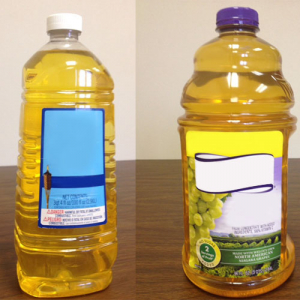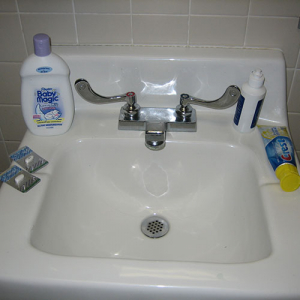Poisoning Prevention
-
Comparing commercially available torch fuel with juice.
-
An alternative torch fuel bottle that children are more likely to recognize as dangerous.
-
How well do new parents recognize hazards to their children? These are some props used in our laboratory study.
Poisoning is the fifth leading cause of unintentional child death in the United States. Poisoning leads to over 33,000 annual hospital visits among children under the age of five and over 1.1 million calls to poison control centers about toxic exposures, and costs over $268 million in medical and work-loss costs. A wide range of factors intersect to cause particular pediatric poisoning incidents, but one factor is how children judge the safety of products they discover when unsupervised.
Our research suggests the type of bottle a product is packaged within — the shape, coloring, labeling, and more — influences the likelihood pre-literate children will judge a product as something consumable versus something to avoid. Changes to product packaging, which might be initiated by industry or by policy, could save lives.
Sample Publications
- Richmond, A., Schwebel, D. C., Leung, C. N. P., Vallez, E., Lesage, H., Degeyter, R., Liang, Z., & Stijntjes, G. (2024). Comparing closure compliance and ease of use for consumer product packs designed to reduce access to children. PLOS One, 19, e0284346.
- Richmond, A., Schwebel, D. C., Morgan, C. H., Liang, Z., Boutoille, A., Buso, P., Mata, A., & Stijntjes, G. (2020). The exploration of size and toddler interaction with liquid laundry detergent capsules. PLOS One, 15, e0244481.
- Jovanov, E., Talukder, B. M. S. B., Schwebel, D. C., & Evans, W. D. (2018). Design and implementation of a safe pill bottle. Applied System Innovation, 1, 13.
- Wang, L., Wu, Y., Yin, P., Cheng, P., Liu, Y., Schwebel, D. C., Qi, J., Ning, P., Liu, J., Cheng, X., Zhou, M., & Hu, G. (2018). Poisoning mortality in China, 2006-2016. Bulletin of the World Health Organization, 96, 314-326A.
- Schwebel, D. C., Evans, W. D., Hoeffler, S. E., Marlenga, B. L., Nguyen, S. P., Jovanov, E., Meltzer, D. O., & Sheares, B. J. (2017). Unintentional child poisoning risk: A review of causal factors and prevention studies. Children’s Health Care, 46, 109-130.
- Schwebel, D. C., Wells, H., & Johnston, A. (2015). Children’s recognition of dangerous household products: Child development and poisoning risk. Journal of Pediatric Psychology, 40, 238-250.
- Gaines, J., & Schwebel, D. C. (2009). Recognition of home injury risks by novice parents of toddlers. Accident Analysis and Prevention, 41, 1070-1074.



